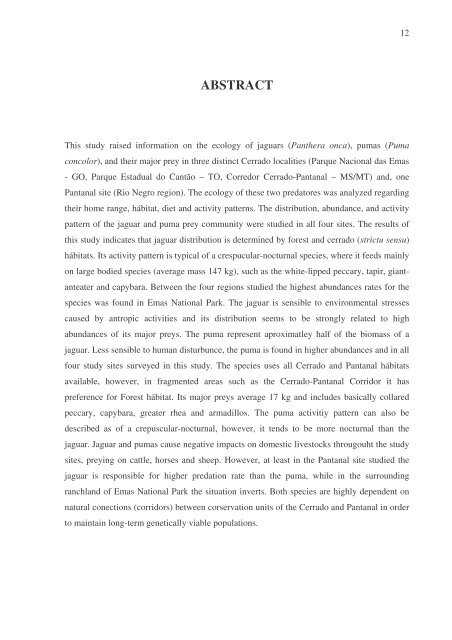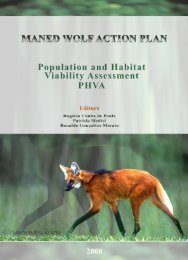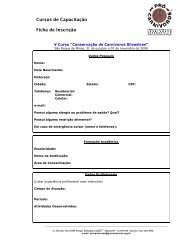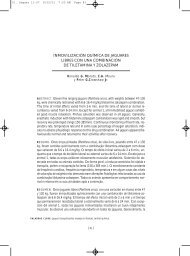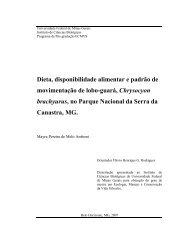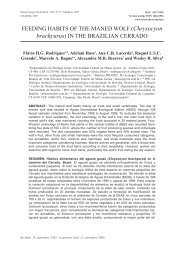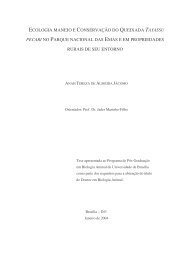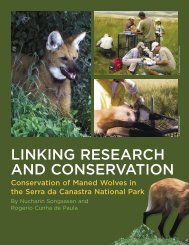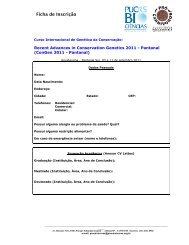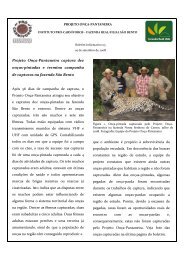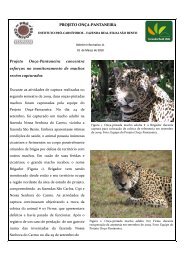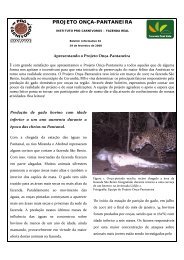- Page 1 and 2: ECOLOGIA COMPARADA E CONSERVAÇÃO
- Page 3 and 4: AGRADECIMENTOS A parte dos agradeci
- Page 5 and 6: diferença na vida acadêmica das p
- Page 7 and 8: Análise estatística .............
- Page 9 and 10: Onças no entorno do Parque Naciona
- Page 11: RESUMO Este estudo reúne informaç
- Page 15 and 16: equilíbrio da comunidade, influenc
- Page 17 and 18: MATERIAIS E MÉTODOS ÁREAS DE ESTU
- Page 19 and 20: A vegetação do Parque é composta
- Page 21 and 22: Figura 2. Limite das propriedades d
- Page 23 and 24: Grande extensão desta região é c
- Page 25 and 26: PARQUE ESTADUAL DO CANTÃO Localiza
- Page 27 and 28: LITERATURA CITADA Ab'Saber, A. N. 1
- Page 29 and 30: CAPÍTULO I ECOLOGIA COMPARADA DA O
- Page 31 and 32: MATERIAIS E MÉTODOS CAPTURA E CONT
- Page 33 and 34: ambiente físico, no caso de ambien
- Page 35 and 36: ESTIMATIVA DE DENSIDADE E SOBREPOSI
- Page 37 and 38: armadilhas não obedeceram a uma di
- Page 39 and 40: leo) e do guepardo (Acinonyx jubatu
- Page 41 and 42: Análise Estatística Para a obten
- Page 43 and 44: RESULTADOS CARACTERIZAÇÃO DAS ESP
- Page 45 and 46: Tabela 5. Medidas de rastros (cm) d
- Page 47 and 48: Apesar de neste estudo terem sido u
- Page 49 and 50: Longitude Figura 2. Área de vida d
- Page 51 and 52: Figura 6. Polígonos das áreas de
- Page 53 and 54: Tabela 8. Percentagem de localizaç
- Page 55 and 56: Longitude Figura 10. Área de Vida
- Page 57 and 58: Tabela 9. Matriz de sobreposição
- Page 59 and 60: Figura 13. Polígonos das áreas de
- Page 61 and 62: Tabela 15. Matriz de captura-recapt
- Page 63 and 64:
identificados, quanto a razão sexu
- Page 65 and 66:
Figura 16. Exemplos de registros fo
- Page 67 and 68:
onças-pintadas apresentaram os mai
- Page 69 and 70:
USO DE HABITAT Os resultados dos re
- Page 71 and 72:
Número de registros fotográficos
- Page 73 and 74:
Figura 24. Interpretação dos háb
- Page 75 and 76:
Figura 26. Uso do hábitat pela on
- Page 77 and 78:
figura 28 ilustra as frequências d
- Page 79 and 80:
Sobreposição de nicho A medida de
- Page 81 and 82:
Amazônia, as áreas de vida repres
- Page 83 and 84:
egular. É provável que estes gran
- Page 85 and 86:
esperar que suas necessidades energ
- Page 87 and 88:
possuem uma visão adaptada tanto p
- Page 89 and 90:
Tabela 26. Medidas de amplitude nic
- Page 91 and 92:
• A distribuição de hábitats p
- Page 93 and 94:
detection, and recommendations for
- Page 95 and 96:
Washington, DC, and Wildlife Conser
- Page 97 and 98:
Rabinowitz, A. R. e Nottigham Jr, B
- Page 99 and 100:
White, G. e Garrot, R. 1991. Análi
- Page 101 and 102:
outros exemplos, descrevendo as rel
- Page 103 and 104:
Figura 1. Exemplo dos dois métodos
- Page 105 and 106:
problema seria a simples padroniza
- Page 107 and 108:
ESTIMATIVA DE DENSIDADE Num censo a
- Page 109 and 110:
O INVAL é denominado indicador sim
- Page 111 and 112:
Mustelidae Conepatus semistriatus J
- Page 113 and 114:
Tabela 3. Abundância acumulada de
- Page 115 and 116:
Cutia 0,014 0,082 0,074 0,003 Paca
- Page 117 and 118:
Tabela 5. Valores de análise de es
- Page 119 and 120:
Tabela 6. Matriz de Similaridade de
- Page 121 and 122:
Tabela 8. Estimativas populacionais
- Page 123 and 124:
Taxa Fotográfica 8.0 7.0 6.0 5.0 4
- Page 125 and 126:
DISTRIBUIÇÃO E ABUNDÂNCIA DE ON
- Page 127 and 128:
A) B) Figura 9. A) Relação entre
- Page 129 and 130:
Carnivora Felidae Onça-pintada Pan
- Page 131 and 132:
espécies de ambientes fechados e d
- Page 133 and 134:
exigências ambientais da onça-pin
- Page 135 and 136:
existe a presença humana. Esse tal
- Page 137 and 138:
• Onças-pintadas e onças-pardas
- Page 139 and 140:
Jackson, R. e Ahlborn, G. 1988. A r
- Page 141 and 142:
Silveira, L.; Jácomo, A. T. A. e D
- Page 143 and 144:
secas de hábitats mais abertos, al
- Page 145 and 146:
Desde meados do século XIX, quando
- Page 147 and 148:
Figura 1. Caracterização do uso d
- Page 149 and 150:
A comunidade rural das propriedades
- Page 151 and 152:
60 50 40 30 20 10 0 44 53 Ano 2000
- Page 153 and 154:
O Pantanal representa o maior bloco
- Page 155 and 156:
odontologia e outras áreas afins p
- Page 157 and 158:
propriedades. As campanhas tiveram
- Page 159 and 160:
Dentre as 11 Fazendas monitoradas n
- Page 161 and 162:
Santa Sophia 30-Maio-03 Onça-parda
- Page 163 and 164:
propriedades (exceto a Fazendinha)
- Page 165 and 166:
Tabela 5. Total de atendimentos rea
- Page 167 and 168:
Tabela 6. Total de consultas médic
- Page 169 and 170:
Foram realizados quatro encaminhame
- Page 171 and 172:
projeto faz limites com a Fazenda S
- Page 173 and 174:
Vantagens Desvantagens 1) A ocorrê
- Page 175 and 176:
proibitivos ou não sejam estrategi
- Page 177 and 178:
Entre os conflitos homem/produção
- Page 179 and 180:
fiscalização, onde o monitorament
- Page 181 and 182:
implementação de programas para r
- Page 183 and 184:
LITERATURA CITADA Acorn, R. C. e Do
- Page 185 and 186:
Jackson, R. e Wangchuck, R. 2001. L
- Page 187 and 188:
Prins, H. H. T.; Grootenhuis, J. G.
- Page 189 and 190:
CAPÍTULO IV CONSERVAÇÃO DA ONÇA
- Page 191 and 192:
predação e dispersão de sementes
- Page 193 and 194:
(Silveira & Jácomo, 2002). Para ev
- Page 195 and 196:
área total de UC’s. As demais 38
- Page 197 and 198:
APA Tabatinga Morro da Pedreira 66,
- Page 199 and 200:
Atualmente, em 24 (56%), das 43 UC
- Page 201 and 202:
CORREDORES DE DISPERSÃO Um total d
- Page 203 and 204:
Tabela 7. Distâncias (km) entre Un
- Page 205 and 206:
Figura 5. Mapa de Unidades de Conse
- Page 207 and 208:
PNE Rios: das Mortes e Fragmentos A
- Page 209 and 210:
Quadro 3. Principais conexões natu
- Page 211 and 212:
RPPN ED Aricá-Mirim, Cuiabá RPPN
- Page 213 and 214:
Quadro 5. Principais conexões natu
- Page 215 and 216:
DISCUSSÃO DISTRIBUIÇÃO ATUAL DE
- Page 217 and 218:
pintadas no Pantanal está em cresc
- Page 219 and 220:
nome da unidade foi escolhido levan
- Page 221 and 222:
cultural, científico e recreativo
- Page 223 and 224:
divisa com os Estados do Mato Gross
- Page 225 and 226:
APA tem características especiais.
- Page 227 and 228:
probabilidade de conservação da o
- Page 229 and 230:
As 110 combinações de corredores
- Page 231 and 232:
Para a região do Parque Nacional d
- Page 233 and 234:
al., 2002). Através desta estraté
- Page 235 and 236:
LITERATURA CITADA Ab'Saber, A. N. 1
- Page 237 and 238:
Mazzolli, M. 1993. Ocorrência de P
- Page 239 and 240:
Silva, J. S.V.; Abdon, M. M.; Boock


